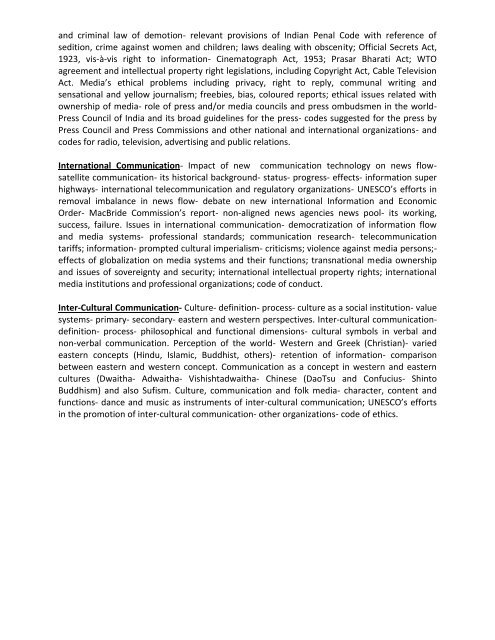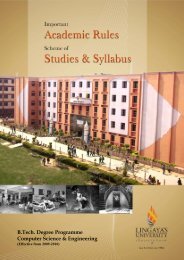Mass CommunicationSyllabus for Ph.D.Principal of Mass Communication- Media systems and theories: authoritarian, libertarian,socialistic, social-responsibility, development, participatory. Mass media: public opinion anddemocracy. Media culture and its production. Media organizations, media content, marketdrivenmedia content- effects, skyvasion, cultural integration and cultural pollution.Issue of media monopoly- cross-media ownership;History of Media- Early communication systems in India- development of printing- early effortsto publish newspapers in different parts of India. Newspapers and magazines in the nineteenthcentury- first war of Indian Independence and the press- issue of freedom, both politicalfreedom and press freedom. Birth of the Indian language press- contribution of Raja RamMohan Roy; birth of the Indian news agencies. The Indian press and freedom movement-Mahatma Gandhi and his journalism; social, political and economic issues before independenceand the Indian press; historical development of important newspapers and magazines inEnglish; important personalities of Indian journalism. The press of India after Independence;social, political and economic issues and the role of the Indian press problems and prospects.Print Media and Electronic Media- Investing reporting- purposes, sources, styles, techniques.Columns- development, criticism, reviews, feature writing, news analysis, backgrounding.-Political reporting -Legislative reporting -Diplomatic reporting.Evolution and growth of electronic media: radio, television and internet. Characteristics orradio, television and Internet as medium of communication- spoken, visual and multipleversions of information through links. Principles and techniques of audio-visual communicationthinking audio and pictures, grammar of sound, visuals and web production.Public Relation and Corporate Communication- Evolution and history of public relationsdefinitionsof PR, PR and allied disciplines (publicity, propaganda, public affairs, lobbying, etc.).Interface of PR with various management disciplines (human resource development, finance,marketing, law, etc.)- publics in PR, PR tools (interpersonal, mass media and selective media)-PR in industry (public sector, private sector and multinational)- PR in central and stategovernments and the functioning of various media units of the State and Union governments.Communication Research- Definition- elements of research- scientific approach- research andcommunication theories- role- function- scope and importance of communication researchbasicand applied research. Research design components- experimental, quasi-experimental,bench mark, longitudinal studies- simulation- panel studies- content analysis. Methods ofcommunication research- census method, survey method, observation method- clinical studiescasestudies- content analysis. Tools of data collection: sources, media source books,questionnaire and schedules, people’s meter, diary method, field studies, logistic groups, focusgroups, telephone, surveys, online polls. Random sampling methods and representativeness ofthe samples, sampling errors and distributions in the findings.Media Law and Ethics Media Law: Constitution of India: fundamental rights- freedom ofspeech and expression and their limits- provisions of declaring emergency and their effects onmedia- provisions for amending the constitution; provisions for legislature reporting;parliamentary privileges and media; theory of basic structure; union and states; and electioncommission and its machinery. Specified press laws in India- Contempt of Courts Act 1971- civil
and criminal law of demotion- relevant provisions of Indian Penal Code with reference ofsedition, crime against women and children; laws dealing with obscenity; Official Secrets Act,1923, vis-à-vis right to information- Cinematograph Act, 1953; Prasar Bharati Act; WTOagreement and intellectual property right legislations, including Copyright Act, Cable TelevisionAct. Media’s ethical problems including privacy, right to reply, communal writing andsensational and yellow journalism; freebies, bias, coloured reports; ethical issues related withownership of media- role of press and/or media councils and press ombudsmen in the world-Press Council of India and its broad guidelines for the press- codes suggested for the press byPress Council and Press Commissions and other national and international organizations- andcodes for radio, television, advertising and public relations.International Communication- Impact of new communication technology on news flowsatellitecommunication- its historical background- status- progress- effects- information superhighways- international telecommunication and regulatory organizations- UNESCO’s efforts inremoval imbalance in news flow- debate on new international Information and EconomicOrder- MacBride Commission’s report- non-aligned news agencies news pool- its working,success, failure. Issues in international communication- democratization of information flowand media systems- professional standards; communication research- telecommunicationtariffs; information- prompted cultural imperialism- criticisms; violence against media persons;-effects of globalization on media systems and their functions; transnational media ownershipand issues of sovereignty and security; international intellectual property rights; internationalmedia institutions and professional organizations; code of conduct.Inter-Cultural Communication- Culture- definition- process- culture as a social institution- valuesystems- primary- secondary- eastern and western perspectives. Inter-cultural communicationdefinition-process- philosophical and functional dimensions- cultural symbols in verbal andnon-verbal communication. Perception of the world- Western and Greek (Christian)- variedeastern concepts (Hindu, Islamic, Buddhist, others)- retention of information- comparisonbetween eastern and western concept. Communication as a concept in western and easterncultures (Dwaitha- Adwaitha- Vishishtadwaitha- Chinese (DaoTsu and Confucius- ShintoBuddhism) and also Sufism. Culture, communication and folk media- character, content andfunctions- dance and music as instruments of inter-cultural communication; UNESCO’s effortsin the promotion of inter-cultural communication- other organizations- code of ethics.
















